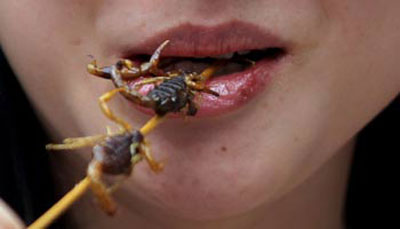|
Insects, a healthy alternative: report
People throughout
the world have been regularly eating insects as a part of their diets for
centuries, according to a report entitled Edible Insects: Future Prospects
for Food and Feed Security by the United Nations Food and Agricultural
Organization in May.
The earliest citing of entomophagy,
or the consumption of insects as food, can be found in biblical literature
but eating insects was, and still is, taboo in many Western societies, the
report states.
The unconventional nature of
entomophagy has meant that farming insects for food and feed has largely been
absent from the great agricultural innovations in livestock farming that
emerged in past centuries - with a few exceptions, such as bees, silkworms
and scale insects.
Insects have also gone unnoticed by agricultural
research and development agencies worldwide, including the UNFAO. But insect
consumption is not a new concept in many parts of the world, the report says.
From ants to beetle larvae - eaten by
native tribes in Africa and
More than 1,900 insect species have
been documented in literature as edible, most of them in tropical countries.
The most commonly eaten insect groups
are beetles, caterpillars, bees, wasps, ants, grasshoppers, locusts,
crickets, cicadas, leaf- and planthoppers, scale insects, termites,
dragonflies and flies.
Insects are healthy, nutritious
alternatives to mainstream staples such as chicken, pork, beef and even fish,
the report said. Insects promoted as food emit considerably fewer greenhouse
gases than most livestock. Methane, for instance, is produced by only a few
insect groups, such as termites and cockroaches.
Insect rearing is not necessarily a
land-based activity and does not require the clearing of land to expand
production. Ammonia emissions associated with raising insects are also far
lower than those linked to conventional livestock.
Because they are cold-blooded,
insects are very efficient at converting feed into protein. They can also be
fed on organic waste streams.
Insect harvesting and rearing is a
low-tech, low-capital investment option that offers entry even to the poorest
sections of society, such as women and those without land.
Since 2003, the FAO has been working
on promoting the eating of insects in many countries worldwide.
Gao Xiwu, an entomologist at
"A clear and comprehensive food
safety standard is needed to pave the way for promoting insects as
food," he said.
Attempts to include insects in food
management began in 1996 when the China Food and Drug Administration and the
National Health and Family Planning Commission approved more than 30 health
products containing ants. Since then, no progress has been made. (Source:
Source: Xinhuanet
|
Thứ Ba, 8 tháng 10, 2013
Đăng ký:
Đăng Nhận xét (Atom)

Không có nhận xét nào:
Đăng nhận xét